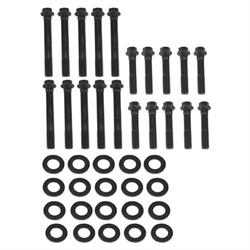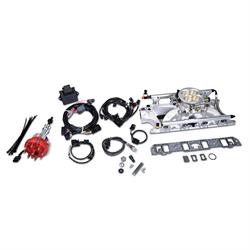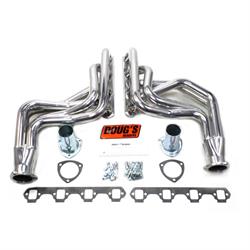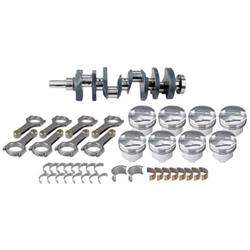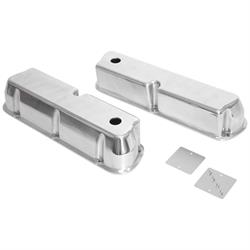Ford 302 Build Combinations: Recipes for 300-500+ HP
Is The Ford 302 A Good Engine?
In production with multiple variants for over 30 years, Ford’s 302 small-block Windsor V8 is regarded as one of the best engines Ford ever made. Known for its reliability, the 302 Ford found its way into just about every vehicle in the Ford-Lincoln-Mercury family—cars, trucks, vans; over 30 vehicles were powered by the 302 small-block Ford throughout its production life. To this day, Ford Performance still sells crate versions of the overhead-valve 302 V8.
Ford first introduced the 302 Windsor engine in 1968. The FIA changed its displacement rules for the 24 Hours of Le Mans, where the legendary 427-powered Ford GT40s had won two years in a row (1966 and 1967), limiting engine size to 5.0-liters. Instead of developing an entirely new engine and wanting to keep production-based engines in all its racing vehicles, Ford stroked the race-proven 289 V8 to 3.00-inches, for a bore and stroke of 4.00 x 3.00, and gave birth to the 302. The GT40 continued to win at Le Mans in 1968 and 1969, with many enthusiasts adopting the 302 for use on road courses, drag strips, and street use. The 302 Ford earned its legendary status with the ’69-’70 Boss 302 Mustangs and Cougar Eliminators, securing the 1970 Trans Am series championship, but the Boss 302 differs greatly from the standard 302 Ford.
Ford 302 engine specs are typical of the day; cast iron 90-degree block with cast iron straight overhead two-valve heads and a pushrod cam-in-block valve train. The small-block Ford was designed to be lightweight and compact and utilized thin-wall casting methods. Stock 302s are known to last well over 100,000 miles, some even being reported as exceeding 500,000 miles with proper maintenance. It’s important to keep an eye on the timing chain assembly, though, as all generations of the Ford 302 were known to last about 75,000 miles. The rear main seals were another common failure point, usually needing replacement at around the 100,000-mile mark.
Are All Ford 302 Engines the Same?
Not all Ford 302 V8s are created equal. Over its many years of production, the 302 saw several changes. From 3-bolt to 4-bolt crankshaft dampers, two-piece and later one-piece rear main seals, flat tappets to roller tappets, and most importantly of all, 28 ounce to 50 ounce external engine balance, these changes happened over the years. While there is a good argument for using an early 302 block for the strength its extra material brings (and simply converting to a roller cam setup), the late 1980s and newer factory roller blocks are usually preferred for any build up to 500 hp. These modern blocks utilize a one-piece rear main seal, taller lifter bores for roller lifter support, and forged pistons in the 1985-1992 high output versions found in the popular Foxbody Mustang and other Ford vehicles. This makes these engines a great starting point for a 350 hp 302 budget build with just bolt on parts.
Identifying a Ford small block 302 can be difficult, as the engine family technically started all the way back in 1962 as a 221ci V8 and quickly grew to 260ci, and then 289ci, and finally 302ci, and shares similar outward appearances including the 6-bolt valve covers, aluminum bolt-on timing cover, and more. The 351 Windsor is technically part of the small block Ford engine family, but we’ll save this big brother for another day. Properly identifying your small block Ford is critical to ensure you order the correct small block Ford 302 build parts.
You can begin your small block Ford ID process by looking at the engine block casting number found on the passenger side rear of the block, just above the starter mounting area. The first four digits of the casting number will tell you if it is a 302 vs the smaller 289 or 260 (good luck finding a 221 these days!). Blocks with casting numbers starting with C8AE or C8TE are the earliest 302s from 1968. Moving into the 1970s the first digit will change to a D, as in D4OE (just one example), while the 1980s would be E, so look for a small block with a casting number starting with an E, such as the popular E5AE and E7TE. The last production 302 block Ford cast was the F1SE used for 1991-1996 production fitments.
How Much HP Does a Ford 302 Have?
At its introduction in 1968, the 302 Ford equipped with a two-barrel carburetor was rated at 210 hp and 300 lb-ft of torque on the SAE gross rating system. An optional four-barrel carb was good for a jump to 230 hp with the same torque. Shelby-built 302s found in the GT350 were rated at 250 hp and 310 lb-ft of torque by adding a high-rise dual plane intake manifold and Holley four-barrel carburetor.
When the emissions era kicked in, compression ratios dropped, and power ratings went with it. The switch to the SAE Net power rating system helped further reduce power figures, going as low as 130 hp in 1974-75 with an 8.0:1 compression ratio. The 1982 H.O. 5.0 was rated at a measly 157 hp, but back up to a somewhat respectable 175 hp in 1984. By 1986, the hi-po 5.0 V8 was back to the 302s original 210 hp, and the following year making a healthy 225 hp. The highest rating a production 302/5.0 V8 achieved was 245 hp in the 1995 Mustang Cobra, but that was also the last year the overhead-valve V8 was equipped in any Ford-Lincoln-Mercury vehicle besides the Explorer and Mountaineer.
The Boss 302 from 1969-1970 is the most powerful version of the 302 small-block built by Ford at 290 hp and 290 lb-ft (in reality power was closer to 350hp, but figures were under-reported for insurance purposes in the height of the muscle car era), but that version is the rarest of all 302 Fords and shares almost no parts interchangeability with other 302s, making it a poor choice for a small block Ford build in anything other than a restoration of a Boss 302 Mustang or Cougar where they were originally used.
How Much Horsepower Can You Get Out of a Ford 302?
While the small block 302 is known for its reliability and compact performance, the thin-wall casting cannot support much more than 500 hp. There are hundreds of online videos, build articles, and real world racing experiences detailing exactly what you can get out of a 302/5.0L Ford with various power adders and build combinations, but to exceed 500 hp reliably it’s best to build with an aftermarket block.
The good news is that a Ford 302 300 hp build is very easily achievable with a junkyard 302 build and a few choice upgrades. With 700 plus hp engines coming from the factory these days, 300 horsepower doesn’t sound like much, but in a Foxbody or SN95 Mustang it’s the perfect combo of streetability and reliability. That power level is even more fun in a classic build like a Falcon or first-gen Mustang, just like our employee Darian and his basic Ford 302 budget build via a Blueprint crate engine, as seen in his Ford 302 engine tech talk for his ’62 Mercury Comet. While we certainly enjoy building our own engines, don’t discount Ford small block 302 engines that ship in a crate ready to go. For larger and heavier cars like a Ford Galaxie or F-series pickup, it doesn’t take much more modification to get to the magic 400 hp 302 build number, which is also a very respectable number for any autocross or road course needs.
To achieve higher Ford 302 hp figures, you’ll need to sacrifice some low-speed drivability, as the required cam and larger intake runners tend to lose a little bit of power at lower RPMs. That doesn’t mean a 500 hp Ford 302 is only suitable on racetracks or drag strips. The right combination of cam, heads, intake, rotating assembly, and boost can turn out dependable and street worthy power, but tuning is paramount. A budget 302 build running factory heads, a mild cam, and upgraded valve springs can be boosted with a big shot of nitrous or a turbo up to around 400 hp, but make sure timing and fuel delivery are perfectly tuned otherwise you risk destroying pistons. Many enthusiasts have reported exceeding 550 hp in street/strip builds, but all it takes is one bad shift or some bad timing to crack a stock 302 block or blow a head gasket. At the end of the day, while big hp numbers on the dyno may be impressive, it is torque that moves you, especially on the street. So be cognizant of your horsepower vs torque goals.
Ford 302 Horsepower Upgrades
With over three decades of small block Ford engines to choose from as a starting point there are plenty of options for making horsepower in the small and light 302 Windsor engine. If you find a screaming deal on an early engine, don’t hesitate to snatch it up for your build, but as we stated above there is a big plus side to starting with a 1985 or later roller cam block. Whichever route you choose, up to and including an aftermarket block for a max effort horsepower build, the name of the game is to optimize engine performance by paying careful attention to compression ratio, camshaft specs, cylinder head airflow numbers, and other important data to build the most efficient engine possible. Remember, engines are nothing more than air pumps and the more efficient you can make them (volumetric efficiency) the more power you can make.
Starting with a solid, but used, small block Ford short block, you can create a cheap 302 build with a fresh top end (heads/cam/intake) that should easily get you close to if not just over the 300 hp mark. If you opt to rebuild Ford 302 engine first, a 400hp 302 build can be achieved two ways: naturally aspirated with a stroker kit rotating assembly, higher compression, bigger heads, and aggressive cam, or a power adder like nitrous, a single turbo, or a supercharger. Either way, you need to make sure you’re getting enough fuel to make that 400 hp 302 build happen.
While stock fasteners and lower end gaskets will suffice for a junkyard 302 build, for higher compression or power adder builds consider upgrading to higher quality cylinder head bolts/studs and premium gasket materials. For a 500 hp Ford 302, you’ll need all the previously mentioned parts: upgraded hardware and gaskets, headers, intake, aftermarket heads with heavy-duty valve train parts, larger fuel injectors or carburetor, forged pistons and connecting rods, and certainly a power adder, too. A popular option is to build a small block Ford stroker and combine it with a power adder to hit that magic 500hp 302 build number. Don’t forget that with the higher horsepower builds it is important to upgrade the small block Ford cooling systems, fuel pump, and ignition system as well!
Ford 302 Budget Build
For the typical junkyard 302 build most will want to maintain the original block and rotating assembly as found unless there is extreme wear. If the engine was serviced regularly the bearing wear and ring wear should be acceptable for a Ford 302 budget build under 300 hp. The first step with a cheap 302 build should be to double check the health of the two most common failure points: the timing chain and rear main seal. Factory timing chains stretch, and some even used nylon gears, providing premature failure points. Upgrading to a double roller style chain is cheap and easy. The rear main seal, like most engine gaskets, is also an easy job best done now before the engine is down on the mounts and running.
Keeping the budget in check while adding performance can be accomplished with basic bolt-on upgrades like an aluminum intake and four-barrel carburetor. Higher flowing tubular headers are another great option. Next would be a more aggressive camshaft and valve springs. Even with stock heads, a decent cam can net a minimum 20 hp, but will see larger gains on higher-flowing aftermarket heads. Be sure to match lifter types and cam profiles, roller lifters are not compatible with flat tappet cams and vice versa. 1984 and earlier blocks used hydraulic flat tappet lifters, then switched to hydraulic rollers in 1985. Of course, you can convert the 1984 and older engines to roller cam via a retrofit cam and lifter package, but we’ll repeat what we said earlier in that it is best to start with a 1985 and later block. Finally, don’t forget the importance the roll of high quality motor oil plays in engine performance and longevity as well.
Ford 302 Budget Build Parts List
Note:
If your budget allows, upgrading to the following cam, lifter, and valve spring kit will work very well with the listed intake and exhaust upgrades above.
300 HP 302 Ford Build Parts List
- Flo-Tek Aluminum Cylinder Heads (two quantity)
- COMP Cams Xtreme Energy Hydraulic Roller Camshaft
- Edelbrock Performer-Link Double Roller Timing Chain
- Edelbrock Performer RPM Dual Plane Intake Manifold
- Holley 670 CFM Carburetor
- Flowtech 1-1/2 Long Tube Headers
- SBF HEI Distributor for OE Roller Cam
- ARP Small Block Ford Head Bolt Kit
- Small Block Ford Gasket Set
Note:
It is quite normal on factory roller cam equipped small block Ford engines to reuse the roller lifters with a new camshaft. If you question the condition of the factory roller lifters, we suggest the following roller lifter SKU to be added to your build list. Additionally, we do not list pushrods, as final pushrod length is determined by several factors.
350 HP 302 Ford Build Parts List
Note:
This offering features a hydraulic flat tappet cam and lifters. These can be used in a later roller cam block if that is the block you’re using for your build.
400 HP 302 Ford Build Parts List
- 347ci Stroker Kit, Cast Crank, I-Beam Rods
- Blueprint Muscle Series 190cc Aluminum Cylinder Heads (two quantity)
- Edelbrock Pro Flow EFI w/ Intake and Throttle Body
- Comp Cams Xtreme Energy Hydraulic Roller Cam and Lifter Kit
- Edelbrock Performer-Link Double Roller Timing Chain
- Patriot Exhaust 1-5/8 Long Tube Headers
- ARP Small Block Ford Head Bolt Kit
- Steel Main Cap Girdle
- Small Block Ford Gasket Set
500 HP 302 Ford Build Parts List
- 347ci Stroker Kit, Forged Crank, H-Beam Rods
- Edelbrock Victor Jr. 210cc Aluminum Cylinder Heads (two quantity)
- Edelbrock Pro Flow EFI w/ Intake and Throttle Body
- Comp Cams Thumpr Hydraulic Roller Cam and Lifter Kit
- Edelbrock Performer-Link Double Roller Timing Chain
- Doug’s Headers 1-3/4 Long Tube Headers
- ARP Small Block Ford Head Bolt Kit
- Steel Main Cap Girdle
- Small Block Ford Gasket Set
How Much Boost Can a Stock 302 Handle?
Whether you’ve got stock forged or hypereutectic pistons in your small block Ford, they are not invincible. The same goes for the stock connecting rods, so don’t expect your junkyard 302 build to last very long if your tuning is way off or you’re cramming excessive amounts of boost into the combustion chambers and not upgrading the rotating assembly to handle it. Mid-1980s to early-1990s stock forged pistons are more forgiving for boosted 302 Fords, but without proper tuning risk melting if ignition isn’t retarded accordingly, or if combustion runs too lean. Using the proper small block Ford ignition parts will help ensure the timing is adjusted as the boost rolls in. Later-1990s hypereutectic pistons do not like a lot of cylinder pressure from boost, and especially nitrous. So be prepared to replace the pistons and connecting rods with forged units before adding copious amounts of boost if you want to build a serious Ford small block 302.
A mild Ford 302 engine build in the 250-horsepower range should survive 5-7 psi of boost with proper tuning and net about 100 hp gains, but as previously cautioned, exceeding 7 psi on a stock 302 rotating assembly can lead to damaged pistons. Anything more than 10 psi on even a fully built 302 Ford with upgraded forged pistons and rods, a beefier cam, higher flowing intake, and heads, and proper fueling and tuning will push cylinder pressures into the 500-plus horsepower danger zone of the stock 302 block. Generally, it is considered a better route to upgrade heads, intake, cam, displacement via a stroker kit and then run lower boost pressures to insure reliability and drivability for a 500 hp 302 build. Building a 400 plus horsepower 347 stroker and then running a blower or turbo at five pounds of boost is a lot safer than a 300 hp heads/cam/intake Ford 302 engine build and pushing double digit boost through it to achieve the same 500 hp 302 build number.
At a certain point, the question is no longer how much boost can a stock 302 handle, but how much boost are you willing to risk. But we all know that everyone is expecting a numerical answer to this quite tricky question. So, we will state that with proper tuning and the appropriate fuel system to back up the power level, it is not unheard of to run 6-8 pounds of boost safely using production Ford 302 engine specs. If the 302 build is designed to handle boost from the start (boost compatible components, proper ring gaps, etc.) you can expect to safely handle 10-12 pounds of boost, especially if you use a water/meth injection system or E85 fuel to keep any piston killing detonation at bay.
Small-Block Ford 302 Engine Upgrades
While we’ve created these build lists to provide an overall look at what it takes to make a certain horsepower level, don’t forget that if you’re building an engine up from a bare block, or even reusing solid short block that you’re simply doing heads/cam/intake on, you may still need additional small block Ford 302 build parts to finish your engine build, some of which may be chassis application specific. Things like water pumps, front accessory drives, oil pans, engine mounts, starters, and more are things to consider finishing off your Ford 302 build and get it down on your project car’s frame rails.
So, you’ve built your dream small block Ford 302, now what? Dress it up! We have all the 302 dress up parts you need to finish off your Ford 302 build. Valve covers, air cleaners, chrome and stainless bolt kits/hardware will put the finishing touches on your engine to make it look its best while putting a smile on your face with all that horsepower! This Ford 302 engine horsepower build guide is intended to be just that, a guide. Please consult your engine builder and the manufacturers to ensure proper fitment and compatibility of all parts for your specific application.











